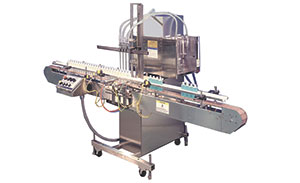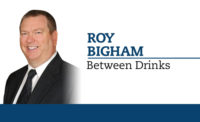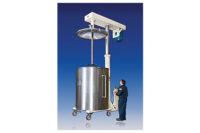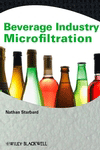When packaging beverages, the process to fill a container can require efficient practices as beverage-makers look to accommodate changeovers that commonly are associated with SKU proliferation. The type of liquid that is being dispensed on the packaging line also comes into consideration in these cases. Advancements throughout the filling industry can help achieve those goals.
In addition to the variety of beverages, beverage manufacturers also have numerous primary packaging choices like aluminum, cardboard, glass, plastic, etc., from which to choose. For larger beverage manufacturers, production and packaging lines might run on a 24-hour cycle, but for smaller operations, it might not be possible to employ the manpower to support those operations. Because of this, it can be important that the filling and packaging shifts operate as efficiently as possible.
Options abound
SIPA S.p.A., Vittorio Veneto, Italy, offers its high-volume fillers for a variety of glass and PET containers with either hot-fill or cold-fill capabilities for carbonated and non-carbonated beverages, the company says. The company can package a variety of beverages including carbonated soft drinks (CSDs), mineral waters, edible oils, milk and dairy products, it says. Mechanical gravity filling or pumped machines are available for cold products as well as hot products that require recirculation in PET or glass bottles. The company also can fill carbonated beverages such as CSDs or beer using isobaric fillers with a range from 16 to 160 filler valves, allowing the output to reach a maximum of 35,000 1.5-liter bottles an hour, the company says. One of its newer products, the Flextronic Platform, is a modular system available in five configurations. The modular design allows structural elements to be shared between the different models and improves maintenance activities, it says. The Flextronic Platform also can achieve production rates from 7,000 to 60,000 bottles an hour with different products and bottle sizes, according to the company.
|
Beverage manufacturers not only desire speed on the filling lines, they also need to ensure the filling levels are consistent throughout the process. Sidel Inc., Norcross, Ga., supplies a collection of filling machines that are designed to match the beverage type to the filling technology with the speed and control systems to develop a filling solution that reduces maintenance costs and provides the lowest total cost of ownership, it says.
Baltimore-based Adcor Industries Inc. began business in the 1960s as a machine shop. In December 2000, the company expanded by acquiring the Century, Uni-Blend and High-Speed Beverage Filling machine products from Crown Simplimatic, Evington, Va. That acquisition gave Adcor about 80 percent of the can- and bottle-filling capacity in North America at the time, according to the company. The company says that with its machining capabilities and ownership of the original equipment drawings from Crown, it can provide any replacement parts needed. In addition to supply parts, the company continues to make conventional and electronic volumetric filling machines. Its Bevcorp mechanical can beverage fillers use 40-130 valves to fill as many as 2,000 cans a minute, and the bottle fillers use 28-120 valves to achieve capacities as high as 1,200 bottles a minute, according to the company.
Not all filling projects require high speed or volume. Filamatic, Baltimore, provides machines that can meet the needs of smaller, startup manufacturers. The company’s machines feature a design that can handle materials from the free-flowing liquids to the more syrupy types, it says. These free-standing units are made of stainless steel constructions with programmable controllers. The nozzle design allows expandability from two to 20 nozzles to grow as needed to meet demand, and the optional touchscreen device provides a human-machine interface that can save more than 100 recipes, the company says.
KHS USA, Waukesha, Wis., offers its ReDiS system, which allows the company to remotely access the equipment from anywhere in the world, it says. The company can run a system fault analysis that provides it with the needed feedback information to give proper advice in real time to maintenance personnel to get the equipment back up and properly running with as little lost time as possible, it says. Such connections can be accomplished via an integrated services for digital network (ISDN) telephone line or virtual private network (VPN) connection over the Internet.
KHS provides machines capable of filling any beverage material at a variable rate depending upon need. For example, its soft drink or beer machines are rated to fill from 22,000 to 58,000 bottles an hour in PET containers, while its can filler can fill 36,000-120,000 cans an hour.
Other filling equipment suppliers also are producing machinery that can accommodate various operation sizes throughout the beverage industry. For example, Inline Filling Systems, Venice, Fla., makes a variety of in-line fillers that mostly are used by the smaller manufacturers. The equipment is adaptable for various pump types including peristaltic, gravity and servo pumps, the company says.
Another filler supplier, Busch Machinery, Tucson, Ariz., explains that a lot of consideration goes into how to properly fill carbonated beverages. The process leading up to the actual filling is similar to non-carbonated water or juice filling in order to prepare the bottles, it says. However, a carbonated beverage should be cooled first by using a chiller to bring the beverage temperature to near freezing, according to the company. A carbonator is used to inject a specific amount of carbon dioxide gas into the premixed beverage and container. The carbonated content then can be inserted into the container in a process known as counter-pressure filling, the company explains. Consideration also must be taken into account when filling cans or bottles. For cans, a nozzle extends to the bottom of the can but the nozzle only extends into the neck of the bottle to eliminate any oxygen in the product. The final product quickly is sealed to preserve the desired pressure, taste and quality, the company says.
In addition to productivity attributes, beverage-makers are seeing energy-saving benefits from filling equipment. KHS’s parent company, KHS GmbH, Dortmund, Germany, recently received a certificate for energy-efficient machines and systems from TÜV SÜD in Munich, Germany, in accordance with TÜV SÜD’s energy and media efficiency standard. The certificate has been granted to KHS’s Innofill Glass filling system for the glass bottling of soft drinks and beer. With the result, KHS is further entitled to use the TÜV SÜD energy and media efficiency quality mark for its glass bottle filler through Nov. 30, 2017. TÜV SÜD has confirmed the low consumption of water and electricity contributed to the high level of sustainability inherent in KHS filling machines, the company says.






